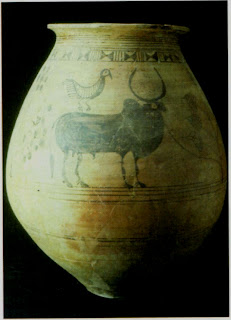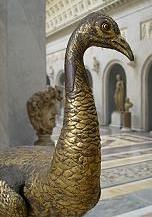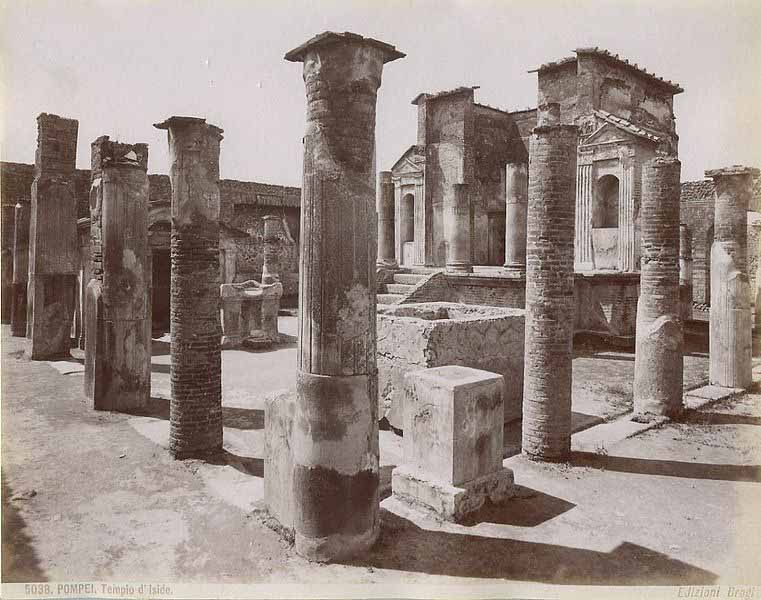https://tinyurl.com/y4rg3582
I posit that paintings on pots of Sarasvati Civilization are Indus Script hypertext inscriptions signifying wealth-accounting ledgers. Thus, if a large storage jar is found in Cemetery H, it is a recollection and ccelebration, as a homage to the memory of the deceased artisan's competence in metalwork and wealth creation for the commonwealth of the guild. This is demonstrated in this monograph.![Image result for indus pottery national museum delhi]() A sherd of pottery with humped bull and birds, Indus Valley, Harappa, c2600 BC.
A sherd of pottery with humped bull and birds, Indus Valley, Harappa, c2600 BC.
A sherd of pottery with humped bull and birds, Indus Valley, Harappa, c2600 BC. (Photo by CM Dixon/Print Collector/Getty Images)
![]() Late Harappan Period dish or lid with perforation at edge for hanging or attaching to large jar. It shows a Blackbuck antelope with trefoil design made of combined circle-and-dot motifs, possibly representing stars. It is associated with burial pottery of the Cemetery H period, dating after 1900 BCE.
Late Harappan Period dish or lid with perforation at edge for hanging or attaching to large jar. It shows a Blackbuck antelope with trefoil design made of combined circle-and-dot motifs, possibly representing stars. It is associated with burial pottery of the Cemetery H period, dating after 1900 BCE.
I suggest that this composite animal shown on the dish or lid on the potsherd from Harappa is a composition of zebu + markhor with wavy horns + tail signified by three prongs. poḷa 'zebu' rebus: poḷa 'magnetite, ferrite ore' PLUS mr̤eka, melh 'goat' Rebus: milakkhu 'coppe' PLUS Wkh. merg f. 'ibex' (CDIAL 9885) Tor. miṇḍ'ram', miṇḍā́l 'markhor' (
The lid or dish also signifies birds perched on the composite animal. The birds are: 1. Aquatic bird; and 2. black drongo.
I posit that paintings on pots of Sarasvati Civilization are Indus Script hypertext inscriptions signifying wealth-accounting ledgers. Thus, if a large storage jar is found in Cemetery H, it is a recollection and ccelebration, as a homage to the memory of the deceased artisan's competence in metalwork and wealth creation for the commonwealth of the guild. This is demonstrated in this monograph.

 Late Harappan Period dish or lid with perforation at edge for hanging or attaching to large jar. It shows a Blackbuck antelope with trefoil design made of combined circle-and-dot motifs, possibly representing stars. It is associated with burial pottery of the Cemetery H period, dating after 1900 BCE.
Late Harappan Period dish or lid with perforation at edge for hanging or attaching to large jar. It shows a Blackbuck antelope with trefoil design made of combined circle-and-dot motifs, possibly representing stars. It is associated with burial pottery of the Cemetery H period, dating after 1900 BCE.I suggest that this composite animal shown on the dish or lid on the potsherd from Harappa is a composition of zebu + markhor with wavy horns + tail signified by three prongs. poḷa 'zebu' rebus: poḷa 'magnetite, ferrite ore' PLUS mr̤eka, melh 'goat' Rebus: milakkhu 'coppe' PLUS Wkh. merg f. 'ibex' (CDIAL 9885) Tor. miṇḍ'ram', miṇḍā́l 'markhor' (
The lid or dish also signifies birds perched on the composite animal. The birds are: 1. Aquatic bird; and 2. black drongo.
Below the rim of the Susa storage pot, the contents are described in Sarasvati Script hieroglyphs/hypertexts: 1. Flowing water; 2. fish with fin; 3. aquatic + black drongo bird tied to a rope Rebus readings of these hieroglyphs/hypertexts signify metal implements from the Meluhha mint.
The birds are read rebus in Meluha
1. karaṇḍa‘duck’ (Samskrtam) rebus: karaḍā 'hard alloy'
2. pōlaḍu. [Tel.] n. An eagle. పసులపోలిగాడు the bird called the Black Drongo. Dicrurus ater. (F.B.I.)(Telugu) पोळ pōḷa 'zebu'& pōlaḍu 'black drongo' signify polad 'steel'.
3. kanku'crane, egret, heron' rebus: kangar'portable furnace'
See: Eureka moment. Like the storage pot described by Mortimer Wheeler in a Mohenjo-daro marketplace, Indus Script Hypertexts on Susa storage pot from Meluhha describe contents: metalware
2. pōlaḍu. [Tel.] n. An eagle. పసులపోలిగాడు the bird called the Black Drongo. Dicrurus ater. (F.B.I.)(Telugu) पोळ pōḷa 'zebu'& pōlaḍu 'black drongo' signify polad 'steel'.
3. kanku'crane, egret, heron' rebus: kangar'portable furnace'
https://tinyurl.com/yd64r2at This narration by Mortimer Wheeler demonstrates that the storage pots with inscriptions were kept in a market baazaar proclaiming the sale of metalwork products. The use of large storage pots to hold metalware and equipment is demonstrated by the Susa pot in Louvre (as vividly demonstrated by Maurizio Tosi). There is clear evidence that the Susa pot now kept in the Louvre Museum contained metalware.
![]()
See: http://bharatkalyan97.blogspot.com/2017/03/in-memoriam-prof-maurizio-tosi.html
See:
Meluhha metalwork of Indus Script are paired śabda-jāti (word sounds), artha-jāti (wealth-repository words). This monograph presented the framework for Mlecchita vikalpa (Meluhha cipher) with examples of animal hieroglyphs as rebus representations of metalwork wealth repository.
http://bharatkalyan97.blogspot.com/2018/10/an-inscribed-pot-with-indus-script.html
![https://tinyurl.com/y8aexctz]() https://tinyurl.com/yajea5yx The inscription on the pot described by Mortimer Wheeler in a BBC documentary is a proclamation that inscribed (authenticated) brass ingots, inscribed metal castings from furnace are offered for barter (sale) and contained in the storage pot. The reference to this pot in an archaeological context is detailed by Mortimer Wheeler from -16:31 to -15:44 of the video presented herein.
https://tinyurl.com/yajea5yx The inscription on the pot described by Mortimer Wheeler in a BBC documentary is a proclamation that inscribed (authenticated) brass ingots, inscribed metal castings from furnace are offered for barter (sale) and contained in the storage pot. The reference to this pot in an archaeological context is detailed by Mortimer Wheeler from -16:31 to -15:44 of the video presented herein.
![]() This signifies brass ingot dula 'two' rebus: dul 'metal casting' PLUS kuṭi 'curve; kuṭika— 'bent' MBh. Rebus: kuṭila, katthīl = bronze (8 parts copper and 2 parts tin) bhaṭa ‘warrior’ rebus: baṭa‘iron’ (Gujarati)
This signifies brass ingot dula 'two' rebus: dul 'metal casting' PLUS kuṭi 'curve; kuṭika— 'bent' MBh. Rebus: kuṭila, katthīl = bronze (8 parts copper and 2 parts tin) bhaṭa ‘warrior’ rebus: baṭa‘iron’ (Gujarati)![]() Sign 15 This is composed of Sign 12 and Sign 342 This Hypertext Sign 15 signifies kuṭhi kaṇḍa kanka ‘smelting furnace account (scribe)’.
Sign 15 This is composed of Sign 12 and Sign 342 This Hypertext Sign 15 signifies kuṭhi kaṇḍa kanka ‘smelting furnace account (scribe)’.
It will be seen from Sign 15 that the basic framework of a water-carrier hieroglyph (Sign 12) is superscripted with another hieroglyph component, Sign 342: 'Rim of jar' to result in Sign 15. Thus, Sign 15 is composed of two hieroglyph components: Sign 12 'water-carrier' hieroglyph; Sign 342: "rim-of-jar' hieroglyph (which constitutes the inscription on Daimabad Seal 1).
kaṇḍ kanka ‘rim of jar’; Rebus: karṇaka ‘scribe’; kaṇḍ ‘furnace, fire-altar’. Thus the ligatured Glyph is decoded: kaṇḍ karṇaka ‘furnace scribe'
![]() Daimabad Seal 1 (Sign 342: Two hieroglyph components: jar with short-neck and rim-of-jar) -- distringuished from broad-mouthed rimless pot which is another Sign hieroglyph.
Daimabad Seal 1 (Sign 342: Two hieroglyph components: jar with short-neck and rim-of-jar) -- distringuished from broad-mouthed rimless pot which is another Sign hieroglyph.
Each hieroglyph component of Sign 15 is read in rebus-metonymy-layered-meluhha-cipher: Hieroglyph component 1: kuṭi 'woman water-carrier' rebus: kuṭhi 'smelter' furnace for iron/kuṭila, 'tin metal'. Hieroglyph component 2: kanka, kārṇī-ka 'rim-of-jar' rebus: kanka, kārṇī-ka m. ʻsupercargo of a shipʼ 'scribe'.
![]() This hypertext signifies the hypertext reads: dul kuṭila 'cast brass' (from) bhaṭa 'warrior' Rebus: bhaṭa 'furnace'.
This hypertext signifies the hypertext reads: dul kuṭila 'cast brass' (from) bhaṭa 'warrior' Rebus: bhaṭa 'furnace'.
Decipherment of Harappa zebu figurine with oval spots: magnetite ingots http://tinyurl.com/o75bok6 wherein a zebu figurine with oval spots has been presented.

See: http://bharatkalyan97.blogspot.com/2017/03/in-memoriam-prof-maurizio-tosi.html
See:
http://bharatkalyan97.blogspot.com/2017/05/indus-script-examples-of-paired-sabda.html Mirror: http://tinyurl.com/l4uxwhn
https://www.facebook.com/srini.kalyanaraman/posts/10156201554499625
Clay storage pot discovered in Susa (Acropole mound), ca. 2500-2400 BCE (h. 20 ¼ in. or 51 cm). Musee du Louvre. Sb 2723 bis (vers 2450 avant J.C.)
The hieroglyphs and Meluhha rebus readings on this pot from Meluhha are: 1. kāṇḍa 'water' rebus: khāṇḍā 'metal equipment'; 2. aya, ayo 'fish' rebus: aya 'iron' ayas 'metal alloy'; khambhaṛā 'fish fin' rebus: kammaṭ a 'mint, coiner, coinage' 3. करड m. a sort of duck -- f. a partic. kind of bird ; S. karaṛa -ḍhī˜gu m. a very large aquatic bird (CDIAL 2787) karaṇḍa‘duck’ (Samskrtam) rebus: karaḍā 'hard alloy'; PLUS 4. meṛh 'rope tying to post, pillar’ rebus meḍ‘iron’ med ‘copper’ (Slavic)
Susa pot is a ‘Rosetta stone’ for Sarasvati Script
Water (flow)
kāṇḍa 'water' rebus: kāṇḍa 'implements
The vase a la cachette, shown with its contents. Acropole mound, Susa.[20]
The vase a la cachette, shown with its contents. Acropole mound, Susa.[20]
It is a remarkable 'rosetta stone' because it validates the expression used by Panini: ayaskāṇḍa अयस्--काण्ड [p= 85,1] m. n. " a quantity of iron " or " excellent iron " , (g. कस्का*दि q.v.). The early semantics of this expression is likely to be 'metal implements compared with the Santali expression to signify iron implements: meď 'copper' (Slovāk), mẽṛhẽt,khaṇḍa (Santali) मृदु mṛdu,’soft iron’ (Samskrtam).
Sarasvati Script hieroglyphs painted on the jar are: fish, quail and streams of water;
aya 'fish' (Munda) rebus: aya 'iron' (Gujarati) ayas 'metal' (Rigveda) khambhaṛā 'fin' rebus: kammaṭa 'mint' Thus, together ayo kammaṭa, 'metals mint'
baṭa 'quail' Rebus: bhaṭa 'furnace'.
karaṇḍa 'duck' (Sanskrit) karaṛa 'a very large aquatic bird' (Sindhi) Rebus: करडा karaḍā 'Hard from alloy--iron, silver &c'. (Marathi) PLUS meRh 'tied rope' meṛh f. ʻ rope tying oxen to each other and to post on threshing floor ʼ (Lahnda)(CDIAL 10317) Rebus: mūhā mẽṛhẽt = iron smelted by the Kolhes and formeḍinto an equilateral lump a little pointed at each end; mẽṛhẽt, meḍ ‘iron’ (Mu.Ho.)
Thus, read together, the proclamation on the jar by the painted hieroglyphs is: baṭa meṛh karaḍā ayas kāṇḍa 'hard alloy iron metal implements out of the furnace (smithy)'.
This is a jar closed with a ducted bowl. The treasure called "vase in hiding" was initially grouped in two containers with lids. The second ceramic vessel was covered with a copper lid. It no longer exists leaving only one. Both pottery contained a variety of small objects form a treasure six seals, which range from Proto-Elamite period (3100-2750 BCE) to the oldest, the most recent being dated to 2450 BCE (First Dynasty of Ur).
Therefore it is possible to date these objects, this treasure. Everything included 29 vessels including 11 banded alabaster, mirror, tools and weapons made of copper and bronze, 5 pellets crucibles copper, 4 rings with three gold and a silver, a small figurine of a frog lapis lazuli, gold beads 9, 13 small stones and glazed shard.
"In the third millenium Sumerian texts list copper among the raw materials reaching Uruk from Aratta and all three of the regions Magan, Meluhha and Dilmun are associated with copper, but the latter only as an emporium. Gudea refers obliquely to receiving copper from Dilmun: 'He (Gudea) conferred with the divine Ninzaga (= Enzak of Dilmun), who transported copper like grain deliveries to the temple builder Gudea...' (Cylinder A: XV, 11-18, Englund 1983, 88, n.6). Magan was certainly a land producing the metal, since it is occasionally referred to as the 'mountain of copper'. It may also have been the source of finished bronze objects."
"Susa... profound affinity between the Elamite people who migrated to Anshan and Susa and the Dilmunite people... Elam proper corresponded to the plateau of Fars with its capital at Anshan. We think, however that it probably extended further north into the Bakhtiari Mountains... likely that the chlorite and serpentine vases reached Susa by sea... From the victory proclamations of the kings of Akkad we also learn that the city of Anshan had been re-established, as the capital of a revitalised political ally: Elam itself... the import by Ur and Eshnunna of inscribed objects typical of the Harappan culture provides the first reliable chronological evidence. [C.J. Gadd, Seals of ancient style found at Ur, Proceedings of the British Academy, XVIII, 1932; Henry Frankfort, Tell Asmar, Khafaje and Khorsabad, OIC, 16, 1933, p. 50, fig. 22). It is certainly possible that writing developed in India before this time, but we have no real proof. Now Susa had received evidence of this same civilisation, admittedly not all dating from the Akkadian period, but apparently spanning all the closing years of the third millennium (L. Delaporte, Musee du Louvre. Catalogues des Cylindres Orientaux..., vol. I, 1920pl. 25(15), S.29. P. Amiet, Glyptique susienne,MDAI, 43, 1972, vol. II, pl. 153, no. 1643)... B. Buchanan has published a tablet dating from the reign of Gungunum of Larsa, in the twentieth century BC, which carries the impression of such a stamp seal. (B.Buchanan, Studies in honor of Benno Landsberger, Chicago, 1965, p. 204, s.). The date so revealed has been wholly confirmed by the impression of a stamp seal from the group, fig. 85, found on a Susa tablet of the same period. (P. Amiet, Antiquites du Desert de Lut, RA, 68, 1974, p. 109, fig. 16. Maurice Lambert, RA, 70, 1976, p. 71-72). It is in fact, a receipt of the kind in use at the beginning of the Isin-Larsa period, and mentions a certain Milhi-El, son of Tem-Enzag, who, from the name of his god, must be a Dilmunite. In these circumstances we may wonder if this document had not been drawn up at Dilmun and sent to Susa after sealing with a local stamp seal. This seal is decorated with six tightly-packed, crouching animals, characterised by vague shapes, with legs under their bodies, huge heads and necks sometimes striped obliquely. The impression of another seal of similar type, fig. 86, depicts in the centre a throned figure who seems to dominate the animals, continuing a tradition of which examples are known at the end of the Ubaid period in Assyria... Fig. 87 to 89 are Dilmun-type seals found at Susa. The boss is semi-spherical and decorated with a band across the centre and four incised circles. [Pierre Amiet, Susa and the Dilmun Culture, pp. 262-268].
Meluhha metalwork of Indus Script are paired śabda-jāti (word sounds), artha-jāti (wealth-repository words). This monograph presented the framework for Mlecchita vikalpa (Meluhha cipher) with examples of animal hieroglyphs as rebus representations of metalwork wealth repository.
More examples of this cipher from Indus Script Corpora are presented.
Black drongo bird
పసి (p. 730) pasi pasi. [from Skt. పశువు.] n. Cattle. పశుసమూహము, గోగణము. The smell of cattle, పశ్వాదులమీదిగాలి, వాసన. పసిపట్టు pasi-paṭṭu. To scent or follow by the nose, as a dog does a fox. పసిగొను to trace out or smell out. వాసనపట్టు. మొసలి కుక్కను పసిపట్టి when the crocodile scented the dog. పసులు pasulu. n. plu. Cattle, గోవులు. పసిగాపు pasi-gāpu. n. A herdsman, గోపకుడు పసితిండి pasi-tinḍi. n. A tiger, పెద్దపులి. పసులపోలిగాడు pasula-pōli-gāḍu. n. The Black Drongo or King crow, Dicrurusater. (F.B.I.) ఏట్రింత. Also, the Adjutant. తోకపసులపోలిగాడు the Raquet-tailed Drongo shrike. Jerdon. No. 55. 56. 59. కొండ పనులపోలిగాడు the White bellied Drongo, Dicrurus coerulescens. వెంటికపనుల పోలిగాడు the Hair-crested Drongo, Chibia hottentotta. టెంకిపనుల పోలిగాడు the larger Racket-tailed Drongo, Dissemurus paradiseus (F.B.I.) పసులవాడు pasula-vāḍu. n. A herdsman, గొల్లవాడు.
"With short legs, they sit upright on thorny bushes, bare perches or electricity wires. They may also perch on grazing animals."(Whistler, Hugh (1949). Popular handbook of Indian birds (4th ed.). Gurney and Jackson, London. pp. 155–157.) https://en.wikipedia.org/wiki/Black_drongo
Hieroglyph: eagle పోలడు [ pōlaḍu ] , పోలిగాడు or దూడలపోలడు pōlaḍu. [Tel.] n. An eagle. పసులపోలిగాడు the bird called the Black Drongo. Dicrurus ater. (F.B.I.)(Telugu) पोळ pōḷa 'zebu'& pōlaḍu 'black drongo' signify polad 'steel
![Image result for bird zebu fish bull indus seal]() A zebu bull tied to a post; a bird above. Large painted storage jar discovered in burned rooms at Nausharo, ca. 2600 to 2500 BCE. पोळ pōḷa, 'Zebu, bos indicus' pōlaḍu, 'black drongo' rebus: pōlaḍ 'steel'; पोळ pōḷa, 'Zebu, bos indicus' of Sarasvati Script corpora is rebus:pōlāda'steel', pwlad (Russian), fuladh (Persian) folādī (Pashto)
A zebu bull tied to a post; a bird above. Large painted storage jar discovered in burned rooms at Nausharo, ca. 2600 to 2500 BCE. पोळ pōḷa, 'Zebu, bos indicus' pōlaḍu, 'black drongo' rebus: pōlaḍ 'steel'; पोळ pōḷa, 'Zebu, bos indicus' of Sarasvati Script corpora is rebus:pōlāda'steel', pwlad (Russian), fuladh (Persian) folādī (Pashto)
pōḷa 'zebu' rebus: pōḷa 'magnetite, ferrite ore) pōladu 'black drongo bird' rebus: pōḷad 'steel' The semantics of bull (zebu) PLUS black drongo bird are the reason why the terracotta bird is shown with a bull's head as a phonetic determinative to signify 'steel/magnetite ferrite ore'. పోలడు (p. 820) pōlaḍu , పోలిగాడు or దూడలపోలడు pōlaḍu. [Tel.] n. An eagle. పసులపోలిగాడు the bird called the Black Drongo. Dicrurus ater. (F.B.I.) rebus: pōlaḍu 'steel' (Russian. Persian) PLUSwings/plumage
"With short legs, they sit upright on thorny bushes, bare perches or electricity wires. They may also perch on grazing animals."(Whistler, Hugh (1949). Popular handbook of Indian birds (4th ed.). Gurney and Jackson, London. pp. 155–157.) https://en.wikipedia.org/wiki/Black_drongo
http://bharatkalyan97.blogspot.com/2018/10/an-inscribed-pot-with-indus-script.html
An old documentry on Mohenjo Daro by BBC.
Video URL https://www.facebook.com/HeritageNgo/videos/992997067535021/ (Video 28:51)
Sir Mortimer Wheeler's 1957 tour of Mohenjo-daro, although outdated in many ways, has some great footage, close shots of Indus objects, and an engaging host. Gripping to Indus fans.
The documentary provides a remarkable evidence on an artifact with Indus Script inscription which is a Hypertext.
The Indus Script Inscription is imprinted (from a seal) on a pot which has been used as a storage pot on the Mohenjo-daro market for sale.
Clearly, the inscription is a description of the item offered for sale and held in the pot.
A storage pot on the left front of this photograph has an Indus Script inscription -- a proclamation of product on sale held in the pot.
The inscription on the small pot is presented on this enlarged image of the small storage pot.
What does the Indus Script Hypertext which has two hypertexts signify?
Thus, the two hypertexts together signify a proclamation that inscribed (authenticated) brass metal (iron) ingots, inscribed metal castings are offered for barter (sale) and contained in the storage pot.
Identifying Meluhha gloss for parenthesis hieroglyph or ( ) split ellipse: குடிலம்¹ kuṭilam, n. < kuṭila. 1. Bend curve, flexure; வளைவு. (திவா.) (Tamil) In this reading, the Sign 12 signifies a specific smelter for tin metal: kuṭi 'woman water-carrier' rebus: rebus: kuṭhi 'smelter' furnace for iron/ kuṭila, 'tin (bronze)metal; kuṭila, katthīl = bronze (8 parts copper and 2 parts tin) [cf. āra-kūṭa, ‘brass’ (Samskritam)
It will be seen from Sign 15 that the basic framework of a water-carrier hieroglyph (Sign 12) is superscripted with another hieroglyph component, Sign 342: 'Rim of jar' to result in Sign 15. Thus, Sign 15 is composed of two hieroglyph components: Sign 12 'water-carrier' hieroglyph; Sign 342: "rim-of-jar' hieroglyph (which constitutes the inscription on Daimabad Seal 1).
kaṇḍ kanka ‘rim of jar’; Rebus: karṇaka ‘scribe’; kaṇḍ ‘furnace, fire-altar’. Thus the ligatured Glyph is decoded: kaṇḍ karṇaka ‘furnace scribe'
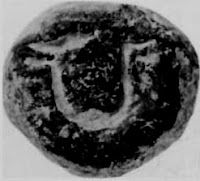 Daimabad Seal 1 (Sign 342: Two hieroglyph components: jar with short-neck and rim-of-jar) -- distringuished from broad-mouthed rimless pot which is another Sign hieroglyph.
Daimabad Seal 1 (Sign 342: Two hieroglyph components: jar with short-neck and rim-of-jar) -- distringuished from broad-mouthed rimless pot which is another Sign hieroglyph.Each hieroglyph component of Sign 15 is read in rebus-metonymy-layered-meluhha-cipher: Hieroglyph component 1: kuṭi 'woman water-carrier' rebus: kuṭhi 'smelter' furnace for iron/kuṭila, 'tin metal'. Hieroglyph component 2: kanka, kārṇī-ka 'rim-of-jar' rebus: kanka, kārṇī-ka m. ʻsupercargo of a shipʼ 'scribe'.
Ligatured hieroglyph 15 using two ligaturing components: 1. water-carrier; 2. rim-of-jar. The ‘rim-of-jar’ glyph connotes: furnace account (scribe). Together with the glyph showing ‘water-carrier’, the ligatured glyphs of kuṭi ‘water-carrier’ + ‘rim-of-jar’ can thus be read as: kuṭhi kaṇḍa kanka ‘smelting furnace account (scribe)’.
bhaṭa 'warrior' Rebus: bhaṭa 'furnace'.PLUS dula 'two' rebus: dul 'metal casting' PLUS kuṭi 'curve; kuṭika— 'bent' MBh. Rebus: kuṭila, katthīl = bronze (8 parts copper and 2 parts tin). Thus, the hypertext reads:dul kuṭila 'cast brass' (from) bhaṭa 'warrior' Rebus: bhaṭa 'furnace'.
The two parenthetical marks ![]() which constitute the circumscript around the ''warrior' hieroglyph are a split lozenge or oval shape Sign 373
which constitute the circumscript around the ''warrior' hieroglyph are a split lozenge or oval shape Sign 373![]() which is an Indus Script Sign.
which is an Indus Script Sign.
 which is an Indus Script Sign.
which is an Indus Script Sign.Sign 373 signifies mũhã̄ 'bun ingot' Sign 373 has the shape of oval or lozenge is the shape of a bun ingot. mũhã̄ = the quantity of iron produced atone time in a native smelting furnace of the Kolhes; iron produced by the Kolhes and formed likea four-cornered piece a little pointed at each end; mūhā mẽṛhẽt = iron smelted by the Kolhes andformed into an equilateral lump a little pointed at each of four ends; kolhe tehen mẽṛhẽt komūhā akata = the Kolhes have to-day produced pig iron (Santali). Thus, Sign 373 signifies word, mũhã̄ 'bun ingot'.
The sign occurs on a zebu, bos indicus to signify a crucible steel cake since poḷa 'zebu, bos indicus' rebus:poḷa 'magnetite, ferrite ore'.
Decipherment of Harappa zebu figurine with oval spots: magnetite ingots http://tinyurl.com/o75bok6 wherein a zebu figurine with oval spots has been presented.
I submit that these oval spots signify पोलाद pōlāda, 'crucible steel cake' explained also as mūhā mẽṛhẽt = iron smelted by the Kolhes and formed into an equilateral lump a little pointed at each of four ends (Santali)
पोलाद pōlāda, 'steel' = ukku 'wootz steel' derived from Vedic utsa 'spring'; eraka, urku 'moltencast'
Slide 33. Early Harappan zebu figurine with incised spots from Harappa. Some of the Early Harappan zebu figurines were decorated. One example has incised oval spots. It is also stained a deep red, an extreme example of the types of stains often found on figurines that are usually found in trash and waste deposits. Approximate dimensions (W x H(L) x D): 1.8 x 4.6 x 3.5 cm. (Photograph by Richard H. Meadow) http://www.harappa.com/figurines/33.html
The oval spots are shaped like the copper ingots shown on this photograh of Maysar, c. 2200 BCE:![]() Maysar c.2200 BCE Packed copper ingots INGOTSmūhā mẽṛhẽt = iron smelted by the Kolhes and formed into an equilateral lump a little pointed at each of four ends (Santali)
Maysar c.2200 BCE Packed copper ingots INGOTSmūhā mẽṛhẽt = iron smelted by the Kolhes and formed into an equilateral lump a little pointed at each of four ends (Santali)![Related image]() Crucible steel button. Steel smelted from iron sand in a graphite crucible.https://commons.wikimedia.org/wiki/File:Crucible_steel_button.jpgDecipherment of the Harappa figurine on Slide 33:
Crucible steel button. Steel smelted from iron sand in a graphite crucible.https://commons.wikimedia.org/wiki/File:Crucible_steel_button.jpgDecipherment of the Harappa figurine on Slide 33:
mūhā mẽṛhẽt = iron smelted by the Kolhes and formed into an equilateral lump a little pointed at each of four ends (Santali)
खोट (p. 212) [ khōṭa ] f A mass of metal (unwrought or of old metal melted down); an ingot or wedge. (Marathi)
The following proverb indicates the exalted status of the zebu, bos indicus which read rebus as पोळ‘magnetite, ferrite ore’ is the life-sustaining wealth of the artisans: ज्याची खावी पोळी त्याची वाजवावी टाळी. Of whom you eat the salt, him laud and exalt. टाळी (p. 196) ṭāḷī f (ताल S) Beating the hands together.pōli-y-eḻuttu , n. < id +. 1. Syllable or letter resembling another in sound, as அய் for ஐ , அவ் for ஔ ஓர் எழுத்துக் குப் பிரதியாகஅவ்வொலியில் அமையும் எழுத்து. (நன் . 124.) 2. Letter substituted for another different in sound, as in சாம்பர் for சாம்பல் ; ஓர் எழுத்துக்குப் பிரதியாக வரும் எழுத்து. (நன்.)
போலியெழுத்து pōli-y-eḻuttu can thus be translated as rebus writing of Indus Script.
I suggest that since the majestic dewlap is the most characteristic feature of the zebu, the following etyma reinforce the identification of zebu,bos indicus as पोळ pōḷa m A bull dedicated to the gods, marked with a trident and discus, and set at large: पोळी pōḷī fig. A dewlap. पोळी पिकणें g. of s. To begin to fare sumptuously; to get into good living.
The oval-shaped incised spots on the zebu figurine signify crucible steel cakes and hence may be calledपोळ pōḷa पोळें pōḷēṃ पोळा pōḷā पोळी pōḷī f. n C A cake-form or flat honeycomb; fig. Any squeezed and compressed cakeform body or mass. पोळी (p. 305) pōḷī f A plain wheaten cake: also a cake composed of rice-flour boiled and rolled up with wheaten. 2 The cake-form portion of a honeycomb. 3 fig. Any squeezed and compressed cakeform body or mass. 4 Cotton steeped in a dye of lác, lodhra &38;c., flattened into the form of a cake, and dried;--forming afterwards, with water, a sort of red ink. 5 fig. A dewlap. पोळी पिकणें g. of s. To begin to fare sumptuously; to get into good living.
The cultural significance attached to the crucible steel cake may be seen from the practice of offering a cake atop the Holi festival fire which is called : होळीची पोळी (p. 527) hōḷīcī pōḷī f The right (of villagers, esp. of the मुखत्यार पाटील) of first placing a पोळी (or cake) upon the pile which is kindled at the close of the festival of the होळी . 2 The cake so designated and applied.
दुपोडी पोळी (p. 237) dupōḍī pōḷī f (दु , पूड, पोळी) A पोळी or stuffed cake doubled up. Sign 294 ![]() is a doubling of a curve.dula 'two' rebus: dul 'metal casting' PLUS kuṭi 'curve; kuṭika— 'bent' MBh. Rebus: kuṭila, katthīl = bronze (8 parts copper and 2 parts tin).
is a doubling of a curve.dula 'two' rebus: dul 'metal casting' PLUS kuṭi 'curve; kuṭika— 'bent' MBh. Rebus: kuṭila, katthīl = bronze (8 parts copper and 2 parts tin).
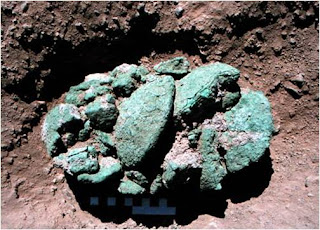
 Crucible steel button. Steel smelted from iron sand in a graphite crucible.https://commons.wikimedia.org/wiki/File:Crucible_steel_button.jpg
Crucible steel button. Steel smelted from iron sand in a graphite crucible.https://commons.wikimedia.org/wiki/File:Crucible_steel_button.jpgmūhā mẽṛhẽt = iron smelted by the Kolhes and formed into an equilateral lump a little pointed at each of four ends (Santali)
खोट (p. 212) [ khōṭa ] f A mass of metal (unwrought or of old metal melted down); an ingot or wedge. (Marathi)
The following proverb indicates the exalted status of the zebu, bos indicus which read rebus as पोळ‘magnetite, ferrite ore’ is the life-sustaining wealth of the artisans: ज्याची खावी पोळी त्याची वाजवावी टाळी. Of whom you eat the salt, him laud and exalt. टाळी (p. 196) ṭāḷī f (ताल S) Beating the hands together.
There is a remarkable expression in Tamil which signifies the homonymous writing of similar sounding words as pictures in Indus Script. The expression is: போலியெழுத்து pōli-y-eḻuttu , n. < id +. 1. Syllable or letter resembling another in sound, as அய் for ஐ , அவ் for ஔ ஓர் எழுத்துக் குப் பிரதியாகஅவ்வொலியில் அமையும் எழுத்து. (நன் . 124.) 2. Letter substituted for another different in sound, as in சாம்பர் for சாம்பல் ; ஓர் எழுத்துக்குப் பிரதியாக வரும் எழுத்து. (நன்.)
போலியெழுத்து pōli-y-eḻuttu can thus be translated as rebus writing of Indus Script.
I suggest that since the majestic dewlap is the most characteristic feature of the zebu, the following etyma reinforce the identification of zebu,bos indicus as पोळ pōḷa m A bull dedicated to the gods, marked with a trident and discus, and set at large: पोळी pōḷī fig. A dewlap. पोळी पिकणें g. of s. To begin to fare sumptuously; to get into good living.
The oval-shaped incised spots on the zebu figurine signify crucible steel cakes and hence may be calledपोळ pōḷa पोळें pōḷēṃ पोळा pōḷā पोळी pōḷī f. n C A cake-form or flat honeycomb; fig. Any squeezed and compressed cakeform body or mass. पोळी (p. 305) pōḷī f A plain wheaten cake: also a cake composed of rice-flour boiled and rolled up with wheaten. 2 The cake-form portion of a honeycomb. 3 fig. Any squeezed and compressed cakeform body or mass. 4 Cotton steeped in a dye of lác, lodhra &38;c., flattened into the form of a cake, and dried;--forming afterwards, with water, a sort of red ink. 5 fig. A dewlap. पोळी पिकणें g. of s. To begin to fare sumptuously; to get into good living.
The smelting processes involved in making such crucible steel cakes are expressed by the following semantics of cognate words: अहारोळी ahārōḷī f (अहार & पोळी) A cake baked on embers.पोळणें pōḷaṇēṃ v i To catch, burn, singe; to be seared or scorched. पोळा pōḷā A kindled portion flying up from a burning mass, a flake. पोळींव pōḷīṃva p of पोळणें Burned, scorched, singed, seared. पोळभाज pōḷabhāja f (पोळणें&38; भाजणें To burn &38;c.) In agriculture. A comprehensive term for the operations connected with the burning of the ground.
The cultural significance attached to the crucible steel cake may be seen from the practice of offering a cake atop the Holi festival fire which is called : होळीची पोळी (p. 527) hōḷīcī pōḷī f The right (of villagers, esp. of the मुखत्यार पाटील) of first placing a पोळी (or cake) upon the pile which is kindled at the close of the festival of the होळी . 2 The cake so designated and applied.
दुपोडी पोळी (p. 237) dupōḍī pōḷī f (दु , पूड, पोळी) A पोळी or stuffed cake doubled up. Sign 294 ![]() is a doubling of a curve.dula 'two' rebus: dul 'metal casting' PLUS kuṭi 'curve; kuṭika— 'bent' MBh. Rebus: kuṭila, katthīl = bronze (8 parts copper and 2 parts tin).
is a doubling of a curve.dula 'two' rebus: dul 'metal casting' PLUS kuṭi 'curve; kuṭika— 'bent' MBh. Rebus: kuṭila, katthīl = bronze (8 parts copper and 2 parts tin).

Mehrgarh, Hakra Ware approximately 3300 BCE. The design embellishments surrounding he markhor appear to be orthographic variants of the trefoil hypertext the significance and rebus reading is provided in this monograph.

Storage jar, ca 2700–2000 BCE. Mature Harappan period. Chanhudaro. Pakistan. National Museum, New Delhi.
The Late Harappan Period at Harappa is represented by the Cemetery H culture (1900-1300 BCE) which is named after the discovery of a large cemetery filled with painted burial urns and some extended inhumations. The earlier burials in this cemetery were laid out much like Harappan coffin burials, but in the later burials, adults were cremated and the bones placed in large urns. (HARP)
 Late Harappan Period large burial urn with ledged rim for holding a bowl-shaped lid. The painted panel around the shoulder of the vessel depicts flying peacocks with sun or star motifs and wavy lines that may represent water. Cemetery H period, after 1900 BCE. These new pottery styles seem to have been introduced at the very end of the Harappan Period. The transitional phase (Period 4) at Harappa has begun to yield richly diverse material remains suggesting a period of considerable dynamism as socio-cultural traditions became realigned. https://www.harappa.com/indus2/164.html
Late Harappan Period large burial urn with ledged rim for holding a bowl-shaped lid. The painted panel around the shoulder of the vessel depicts flying peacocks with sun or star motifs and wavy lines that may represent water. Cemetery H period, after 1900 BCE. These new pottery styles seem to have been introduced at the very end of the Harappan Period. The transitional phase (Period 4) at Harappa has begun to yield richly diverse material remains suggesting a period of considerable dynamism as socio-cultural traditions became realigned. https://www.harappa.com/indus2/164.htmlCemetery H pottery
A painted burial jar on display at the Harappan Civilisation Gallery at the National Museum, Delhi. (Arun Sharma/HT PHOTO)
Burial urn from ca 2000 BC from the Harappan civilization New Delhi National Museum
See:
Pottery with Indus Script hypertexts, wealth-accounting ledgers, metalwork catalogues https://tinyurl.com/yb7ucrfr
This is an addendum to:
1. Body, peacock, ficus Indus Script hypertexts on potsherds signify helmsman metalsmith expertise on calcining metal, copper, iron https://tinyurl.com/yaxhgoka
2.Itihāsa. Mohenjodaro dancing girls' posture is ಕರಣ (Kannada) rebus: करण m. writer,scribe; a class whose occupation is writing, accounts
https://tinyurl.com/yatjsetx
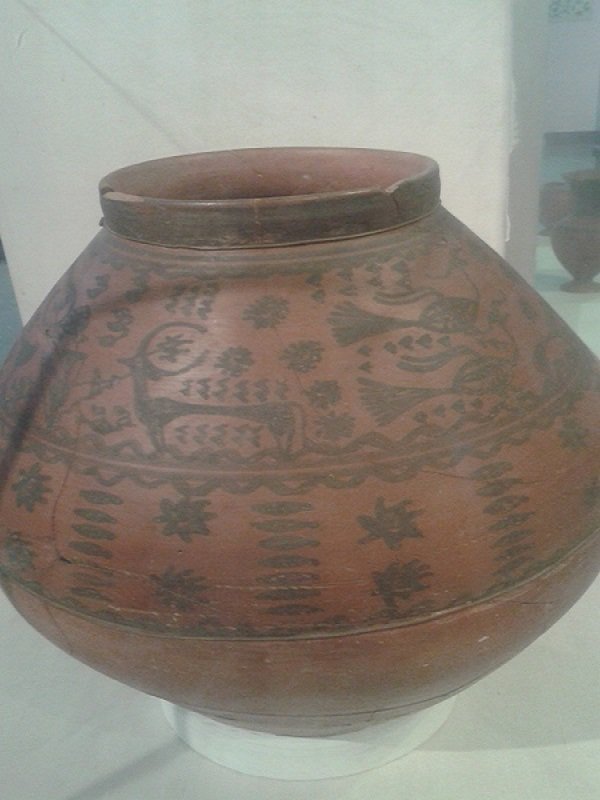
Pot from Indus Valley Sarasvati Civilization. National Museum , Delhi ca. 2000 BCE.
http://www.nationalmuseumindia.gov.in/pdfs/Harappan-Civilization.pdf
maraka 'peacock' rebus: marakaka'copper alloy, calcining metal'
miṇḍā́l 'markhor' (CDIAL 10310) Rebus: meḍ (Ho.); mẽṛhet 'iron' (Munda.Ho.).
mēḍh 'pole star' rebus: mēḍ 'iron' med 'copper' (Slavic) .medhā 'dhana,yajna'
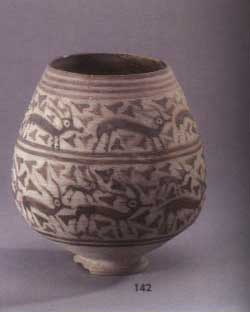
Terracotta slip painted bowl depicting deer. Indus Valley Sarasvati Civilization http://heritage.gov.pk/html_pages/indus_pots.htm

kola 'woman' rebus: kol 'working in iron'
mēḍh 'pole star' rebus: mēḍ 'iron' med 'copper' (Slavic) .medhā 'dhana,yajna'
thattār 'buffalo horn' Rebus: taṭṭār 'brass worker'
See: http://www.bbc.co.uk/schools/primaryhistory/indus_valley/art_and_writing/teachers_resources.shtml Indus Valley Teachers' Resources
http://www.nationalmuseumindia.gov.in/pdfs/Harappan-Civilization.pdf Download the Museum's Activity Book for children.
See:
Vāhana of Sarasvati is peacock/hamsa, 'swan' which is an Indus Script hypertext signifies morakkaka 'calcining metal or calx, bhasma' or hanse 'artisan/merchant guild' https://tinyurl.com/y7wqaauw
 Raja Ravi Varma's painting shows Devi Sarasvati with four hands and a peacock vāhana. mayūˊra m. ʻ peacock ʼ VS., in cmpds. RV., mayūrīˊ -- f. ʻ peahen ʼ RV. 2. *mōra -- . 3. *majjūra -- (< *mayyūra<-> with early eastern change -- yy -- > -- jj -- ?). [mayūka -- , marūka --
Raja Ravi Varma's painting shows Devi Sarasvati with four hands and a peacock vāhana. mayūˊra m. ʻ peacock ʼ VS., in cmpds. RV., mayūrīˊ -- f. ʻ peahen ʼ RV. 2. *mōra -- . 3. *majjūra -- (< *mayyūra<-> with early eastern change -- yy -- > -- jj -- ?). [mayūka -- , marūka -- *mayūrapakṣala -- .Addenda: mayūˊra -- : WPah.kṭg. (kc.) mōr ʻ peacock ʼ.(CDIAL 9865) Ta. maññai, mayil peacock. Ma. mayil. Ko. mi·l. To. mi·s̱. Ka. mayla, maylu. Koḍ. maylï. Tu. mairů. Pa. mañjil, mañil. Ga. (Oll.) mañgil; (S) mayŋīl, (P.) mayŋil. Go. (Tr. W. Ph. Mu. Ma. etc.) mal, (S. Koya Su.) mallu (Voc. 2749). Konḍa (BB) mīril, (K. Sova dial.) mrīlu. Pe. mal (pl. -ku). Manḍ. mel (pl. -ke). Kuimeḍu, melu. Kuwi (F.) mellū, (S.) mellu, (Isr.) melu. / Cf. Skt. mayūra- id.; Turner, CDIAL, no. 9865. (DEDR 4642)
I suggest that the early form of the word for peacock is: māˊrā (Savara); maraka '
![Image result for bharatkalyan97 marakaka]()
The pine cone and the peacocks are Indus Script hypertexts to signify metalwork catalogues: 1. Hieroglyph, signifier: kandə 'pine cone' Rebus, signified metalwork: khaṇḍa. A portion of the front hall, in a temple; kaṇḍ 'fire-altar' (Santali) kāṇḍa 'tools, pots and pans and metal-ware' (Marathi) Rebus:Tu. kandůka, kandaka ditch, trench. Te. kandakamu id. Konḍa kanda trench made as a fireplace during weddings. Pe. kanda fire trench. Kui kanda small trench for fireplace. Malt. kandri a pit. (DEDR 1214).
![]() Water holes in the pine cone can be seen. The bronze piece was part of a water-fountain.
Water holes in the pine cone can be seen. The bronze piece was part of a water-fountain.![Water installation with bronze pine-cone in the atrium of Old St Peter's, Rome. Drawing by Cronaca (1457-1505). Uffizi, Florence, 1572.]() installation with bronze pine-cone in the atrium of Old St Peter’s Basilica, Rome. Drawing by Cronaca (1457-1505). Uffizi, Florence, 1572.
installation with bronze pine-cone in the atrium of Old St Peter’s Basilica, Rome. Drawing by Cronaca (1457-1505). Uffizi, Florence, 1572.![]()
![]() Fontana della Pigna(fountain of the pine cone) in piazza San Marco. This fountain, very close to theAltare della Patria, celebrates the huge bronze sculpture called Pignone(kept in the Vatican museums today).The original statue, almost 4 meters tall, was found in middle ages in this area and gave the name to this neighborhood (rione della pigna). The Pignone was probably a decoration of the ancient roman temple of Isis and Serapis at campo Marzio.
Fontana della Pigna(fountain of the pine cone) in piazza San Marco. This fountain, very close to theAltare della Patria, celebrates the huge bronze sculpture called Pignone(kept in the Vatican museums today).The original statue, almost 4 meters tall, was found in middle ages in this area and gave the name to this neighborhood (rione della pigna). The Pignone was probably a decoration of the ancient roman temple of Isis and Serapis at campo Marzio. ![Related image]()
![Related image]()
![Peacocks]() Bronze Peacock in Hadrian museum, Vatican. See:
Bronze Peacock in Hadrian museum, Vatican. See: ![Image result for peacock vatican]()
The original pine cone. Pigna (Fir cone) is the name of the quarter of Rome where this bronze sculpture was found; it was part of a fountain and it spouted water from holes on its top. It was probably placed in front of a Temple to Isis in Iseo Campense; the gilded peacocks decorated one of the entrances to Hadrian's Mausoleum. The Egyptian lions were added by Pope Gregory XVI; they came from Mostra dell'Acqua Felice and were replaced by copies. http://www.romeartlover.it/Vasi181.html
![]() Logo of the Rione.
Logo of the Rione.![]()
![]()
![Quote Quote]() These pine-cones were a customary feature of the classic fountain, as the scales of the cone present natural and graceful outlets for the falling water. Symmachus’s fountain was one of the beauties of Rome in the days when the great Gothic King Theodoric ruled and loved the city. Three hundred years later it captivated the fancy of Charlemagne, crowned Emperor in St. Peter’s on Christmas Day, 800; and the fountain afterward erected before his great cathedral at Aix [now Aachen Cathedral] is ornamented with a huge pine-cone like the one which he and his Franks had seen in the exquisite fountain of St. Peter’s.
These pine-cones were a customary feature of the classic fountain, as the scales of the cone present natural and graceful outlets for the falling water. Symmachus’s fountain was one of the beauties of Rome in the days when the great Gothic King Theodoric ruled and loved the city. Three hundred years later it captivated the fancy of Charlemagne, crowned Emperor in St. Peter’s on Christmas Day, 800; and the fountain afterward erected before his great cathedral at Aix [now Aachen Cathedral] is ornamented with a huge pine-cone like the one which he and his Franks had seen in the exquisite fountain of St. Peter’s.
http://www.garden-fountains.us/fount...rs-fountain/5/
![hellenismo: bronze peacock from Hadrian’s Mausoleum, now in the Vatican Museum…]()
![]()
![]()
![]() Map of the archaeological complex: Largo di Torre Argentina, Rome, Italy
Map of the archaeological complex: Largo di Torre Argentina, Rome, Italy
![]()
![]()
![]()
![File:Temple de Serapis.JPG]()
![]()
![Temple of Serapis]() This temple was built for the Egyptian merchants. It was located on the Commercial Agora near the western gate. There is also another entrance into the temple from the south-west corner of the Agora through stairs.
This temple was built for the Egyptian merchants. It was located on the Commercial Agora near the western gate. There is also another entrance into the temple from the south-west corner of the Agora through stairs.![Artemis Temple]()
The original pine cone. Pigna (Fir cone) is the name of the quarter of Rome where this bronze sculpture was found; it was part of a fountain and it spouted water from holes on its top. It was probably placed in front of a Temple to Isis in Iseo Campense; the gilded peacocks decorated one of the entrances to Hadrian's Mausoleum. The Egyptian lions were added by Pope Gregory XVI; they came from Mostra dell'Acqua Felice and were replaced by copies. http://www.romeartlover.it/Vasi181.html
It was at Campus Martius prior to it being moved to the Court of the Pigna.
![]() glyph-type symbols below the animal (Courtyard of the Pinecone)
glyph-type symbols below the animal (Courtyard of the Pinecone)
Another version of the pine cone origins:
[quote]The Huge statue known as the Pigna (pine) or the Fontana Della Pigna depicts a giant Pine Cone. It is located in St. Peter's, in an area called the court of the Pigna.The Court of the Pigna is the northern part of the grand renaissance Belvedere Courtyard that stretches between the Papal Palaces to the "palazzetto" which belonged to Innocent VII's . The courtyard was segmented into three parts after the construction of Sixtus V's Library and the Braccio Nuovo of Pius VII. The present courtyard derived its name form the beautiful pine cone statue set into the "nicchone", borders on the south side with the Braccio Nuovo, and on the east it borders with the Chiaromonti Gallery. To its north you can find Innocent VIII's Palazzetto and on the west the galleries of the Apostolic Library are located.
The pine cone was cast out of bronze in the 1st or 2nd century by the sculptor Publius Cincius Slavius. He was identified as its creator because his name was written on the base of the huge pine. The Statue's height is almost 4 meters and on both sides of the pine cone there are bronze peacocks which are copies of the ones in Hadrian's tomb.
Before it was moved to its current location, known as the Court of the Pigna, the statue of the Pine was situated in the Campus Martius. This area is still known today as "Pigna" after this statue. At its previous location it was used as a fountain with the water pouring from holes pierced in the scales of the cone. At the 8th century it was transferred to the entrance hall of the medieval basilica of St. Peter. It was placed decoratively in the middle of the fountain covered by ornate baldachin. We know this because the statue was identified in Renaissance drawings of the hall. Eventually, during the construction of the current basilica, in 1608, the giant pine cone fountain was moved and situated in its current location.
This statue is a beautiful and ancient one and it's definitely worth stopping by and admiring it as it has been part of Rome's landscape for almost 2000 years! [unquote]
http://vatican.com/photos/gallery/court_of_the_pigna-p45![marduk pine cone, pine cone symbolism, pine pollen powder, pine pollen benefits]() Marduk, winged, holding the pine-cone. Bracelet has safflower hieroglyph. Annunaki, Sumerian.
Marduk, winged, holding the pine-cone. Bracelet has safflower hieroglyph. Annunaki, Sumerian.![]()
![]() Technical information
Technical information
Blessing genius Neo-Assyrian period, circa 721-705 BCE (reign of Sargon II)
Third gate of the palace of Sargon II, Khorsabad (ancient Dur-Sharrukin), Iraq
Bas-relief of gypseous alabaster
H. 4.09 m; L. 2.36 m; D. 0.75 m
Victor Place excavations, 1852-54
AO 19863
Near Eastern Antiquities [see: Musée du Louvre] ‘Maize’ and ‘pine-cone’ are two hieroglyphs depicted, respectively, on Indian sculptures at Somnathpur (Lakshmi, divinity of wealth) and on sculptures and reliefs of Ashur (Nimrud). Rebus readings are evidence of presence of Meluhha speakers in the Ancient Near East who participated in the bronze-age inventions of tin-bronzes and created the writing systems of deploying hieroglyphs together with cuneiform and Indus texts.
![]() Halebid."Maize breeders in India, China, United States, and Great Britain, who have seen extensive collections of the illustrations, concur...only sculptors with abundant ears of maize as models could have created these illustrations of maize"(Click to enlarge). Photo by Carl L. Johannessen.
Halebid."Maize breeders in India, China, United States, and Great Britain, who have seen extensive collections of the illustrations, concur...only sculptors with abundant ears of maize as models could have created these illustrations of maize"(Click to enlarge). Photo by Carl L. Johannessen.
![]()
![]()
![]()
Somnathpur, Halebid. Lakshmi. Divinity of wealth holding maize cob or pine-cone.
Hieroglyphs: kandə ʻpineʼ, ‘ear of maize’. Rebus: kaṇḍa ‘tools, pots and pans of metal’. Rebus: kāḍ ‘stone’. Ga. (Oll.) kanḍ, (S.) kanḍu (pl. kanḍkil) stone (DEDR 1298).
In Hindu tradition, vāhana of Sarasvati is also a hamsa. हंस m. (ifc. f(आ). ;
I suggest that the early form of the word for peacock is: māˊrā (Savara); maraka '

The pine cone and the peacocks are Indus Script hypertexts to signify metalwork catalogues: 1. Hieroglyph, signifier: kandə 'pine cone' Rebus, signified metalwork: khaṇḍa. A portion of the front hall, in a temple; kaṇḍ 'fire-altar' (Santali) kāṇḍa 'tools, pots and pans and metal-ware' (Marathi) Rebus:Tu. kandůka, kandaka ditch, trench. Te. kandakamu id. Konḍa kanda trench made as a fireplace during weddings. Pe. kanda fire trench. Kui kanda small trench for fireplace. Malt. kandri a pit. (DEDR 1214).
2. Hieroglyph, signifier: mora, 'peacock' Rebus signified metalwork: morakkhaka loha, 'a kind of copper'; moraka 'a kind of steel'. mora peacock; morā ‘peafowl’ (Hindi); rebus: morakkhaka loha, a kind of copper, grouped with pisācaloha (Pali). [Perhaps an intimation of the color of the metal produced which shines like a peacock blue feather.] moraka "a kind of steel" (Samskritam)Thus, Rupaka or metaphor is: marakaka 'copper alloy, calcining metal'. Peacock as a Meluhha hieroglyph
Hieroglyph pine-cone is kandə Rebus: khaṇḍa. A portion of the front hall, in a temple Hieroglyph peacock is maraka 'Rebus: maraca ‘death’, māraka ‘god of death’; smāraka, 'memorial for ancestors'. ' smará ʻ remembrance ʼ(CDIAL 13861).
In Pali (Rhys Davids' lexicon), jīvan-jīvaka (poss. onomatopoetic) means a bird, a sort of pheasant which utters a note sounding like jīvanjīva (Di_gha III.201)... Also cited is a Jain phrase: jīvanjīveṇa gacchai jīvanjīvenan ciṭṭhai [Weber Bhagavati_ pp. 289,290 with doubtful interpretation "living he goes with life"? or "he goes like the j. bird"?]
The Munda word for peacock marak/mara "cryer, peacock", later Sanskrit māra (and Pali etc) 'death, God Death', the Munda peacock symbol = death, and the Cemetery H peacock pictures on urns with cremated bodies. Peacock and heaven (marak = peacock; merxā_ = sky, heaven ?may the soul go to heaven)
Parji. marp- (mart-)= to lighten; Kurux. merxā_ = sky, heaven; Malto. mergu = sky, heaven; see Te.merūmu = flash of lightning.
Large burial urn. Late Harappan Period large burial urn with ledged rim for holding a bowl-shaped lid. The painted panel around the shoulder of the vessel depicts flying peacocks with sun or star motifs and wavy lines that may represent water. Cemetery H period, after 1900 BC. These new pottery styles seem to have been introduced at the very end of the Harappan Period. The transitional phase (Period 4) at Harappa has begun to yield richly diverse material remains suggesting a period of considerable dynamism as socio-cultural traditions became realigned. Pine-cone as a Meluhha hieroglyph
Sgh. kaḍol mangrove. Ash. piċ -- kandə ʻ pine ʼ, Kt. pṳ̄ċi, piċi, Wg. puċ, püċ (pṳ̄ċ -- kəŕ ʻ pine -- cone ʼ), Pr. wyoċ, Shum. lyēwič (lyē -- ?).(CDIAL 8407). Cf. Gk. peu/kh f. ʻ pine ʼ, Lith. pušìs, OPruss. peuse NTS xiii 229. The suffix –kande in the lexeme: Ash. piċ-- kandə ʻ pine ʼ may be cognate with the bulbous glyphic related to a mangrove root: Koḍ. kaṇḍe root-stock from which small roots grow; ila·ti kaṇḍe sweet potato (ila·ti England). Tu. kaṇḍe, gaḍḍè a bulbous root; Ta. kaṇṭal mangrove, Rhizophora mucronata; dichotomous mangrove, Kandelia rheedii. Ma. kaṇṭa bulbous root as of lotus, plantain; point where branches and bunches grow out of the stem of a palm; kaṇṭal what is bulb-like, half-ripe jackfruit and other green fruits; R. candel. (DEDR 1171). Rebus: kaṇḍa ‘tools, pots and pans of metal’. kanda m. ʻ bulbous root ʼ MBh., n. ʻ garlic ʼ lex. [Prob. with gaṇḍa -- 1 ← Drav. T. Burrow BSOAS xii 369 and EWA i 152 with lit.] Pa. kanda -- m. ʻ bulb, bulbous root ʼ; Pk. kaṁda -- m. ʻ bulbous root ʼ, °dī -- f. ʻ radish ʼ; Or. kandā ʻ edible bulbous root; OMth. kã̄da ʻ bulb ʼ(CDIAL 2723). Rupaka, rebus: लोखंड (p. 723) [ lōkhaṇḍa ] n (लोह S) Iron लोखंडकाम (p. 723) [ lōkhaṇḍakāma ] n Iron work; that portion (of a building, machine &c.) which consists of iron. 2 The business of an ironsmith.लोखंडी (p. 723) [ lōkhaṇḍī ] a (लोखंड ) Composed of iron; relating to iron लोहोलोखंड (p. 723) [ lōhōlōkhaṇḍa ] n (लोह & लोखंड ) Iron tools, vessels, or articles in general.
 Water holes in the pine cone can be seen. The bronze piece was part of a water-fountain.
Water holes in the pine cone can be seen. The bronze piece was part of a water-fountain.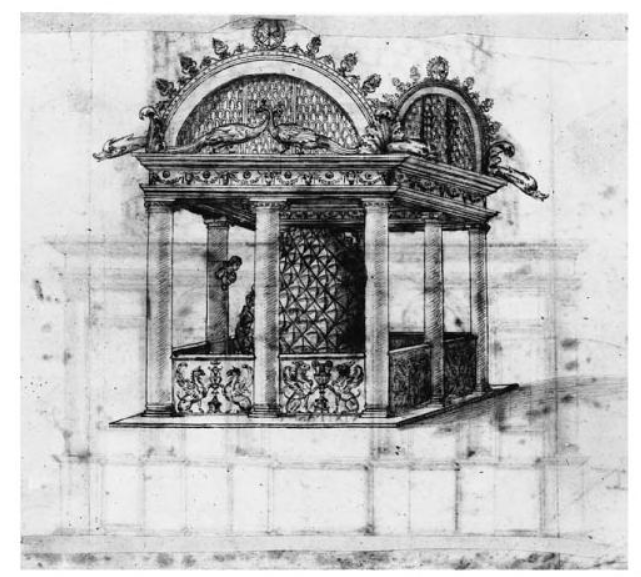 installation with bronze pine-cone in the atrium of Old St Peter’s Basilica, Rome. Drawing by Cronaca (1457-1505). Uffizi, Florence, 1572.
installation with bronze pine-cone in the atrium of Old St Peter’s Basilica, Rome. Drawing by Cronaca (1457-1505). Uffizi, Florence, 1572.Drawing of St.Peter's fountain by Francisco de Hollanda (early 1500s)
One surmise is that the pinecone acted as a fountain in the Baths of Agrippa dated to 1st century BCE.
http://roma.andreapollett.com/S5/rione09.htm
http://roma.andreapollett.com/S5/rione09.htm
The surmise is based on the following evidence:
 Fontana della Pigna(fountain of the pine cone) in piazza San Marco. This fountain, very close to theAltare della Patria, celebrates the huge bronze sculpture called Pignone(kept in the Vatican museums today).The original statue, almost 4 meters tall, was found in middle ages in this area and gave the name to this neighborhood (rione della pigna). The Pignone was probably a decoration of the ancient roman temple of Isis and Serapis at campo Marzio.
Fontana della Pigna(fountain of the pine cone) in piazza San Marco. This fountain, very close to theAltare della Patria, celebrates the huge bronze sculpture called Pignone(kept in the Vatican museums today).The original statue, almost 4 meters tall, was found in middle ages in this area and gave the name to this neighborhood (rione della pigna). The Pignone was probably a decoration of the ancient roman temple of Isis and Serapis at campo Marzio. 
 Bronze Peacock in Hadrian museum, Vatican. See:
Bronze Peacock in Hadrian museum, Vatican. See: Two bronze peacocks, 11 ft. high bronze pine cone at Vatican are Meluhha hieroglyphs, metalwork catalogues. Archaeometallurgical analyses by Vatican suggested http://tinyurl.com/qz56u27

The original pine cone. Pigna (Fir cone) is the name of the quarter of Rome where this bronze sculpture was found; it was part of a fountain and it spouted water from holes on its top. It was probably placed in front of a Temple to Isis in Iseo Campense; the gilded peacocks decorated one of the entrances to Hadrian's Mausoleum. The Egyptian lions were added by Pope Gregory XVI; they came from Mostra dell'Acqua Felice and were replaced by copies. http://www.romeartlover.it/Vasi181.html
Pigna is the name of rione IX of Rome. "Pigna ("pine-cone") refers to a famous bronze sculpture of Roman origin, in the shape of a huge pine-cone. It likely acted as a fountain in the Baths of Agrippa, the first establishment of this kind opened in Rome (late 1st century BC), at the back of the Pantheon's site."
 Logo of the Rione.
Logo of the Rione."Pigna. There used to be a tradition, wholly unfounded, but deeply rooted in the Roman mind, to the effect that the great bronze pine-cone, eleven feet high, which stands in one of the courts of the Vatican, giving it the name c Garden of the Pine-cone,’ was originally a sort of stopper which closed the round aperture in the roof of the Pantheon. The Pantheon stands at one cornerof the Region of Pigna, and a connection between the Region, the Pantheon, and the Pine-cone seems vaguely possible, though altogether unsatisfactory. The truth about the Pine-cone is perfectly well known; it was part of a fountain in Agrippa’s artificial lake in the Campus Martius, of which Pigna was a part, and it was set up in the cloistered garden of Saint Peter’s by Pope Symmachus about fourteen hundred years ago. The lake may have been near the Pantheon." (Crawford, Francis Marion, Ave Roma Immortals, 1898, London, Macmillan & Co. Ltd., p.345)
"Composed of a large bronze pine cone almost four meters high which once spouted water from the top, the Pigna originally stood near the Pantheon next to the Temple of Isis. It was moved to the courtyard of the old St. Peter's Basilica during the Middle Ages and then moved again, in 1608, to its present location." -- Official history on the Vatican website.
The bronze peacocks on either side of the fountain are copies of those decorating the tomb of the Emperor Hadrian, now the Castel Sant' Angelo. http://en.wikipedia.org/wiki/Fontana_della_Pigna. The peacocks decorated the Mausoleum or the tomb of Hadrian erected between 134 and 139 CE. Copies of “Bronze peacocks” maybe from the Mausoleum of Hadrian. The originals are in the New Wing of the Chiaramonti Museum (Braccacio Museum)
Drawing of St.Peter's fountain by
Francisco de Hollanda (early 1500s)
St. Peter's fountain, in a pen drawing by anonymous (c. 1525) "Medieval chronicles such as the famous Mirabilia Urbis Romae (12th century) mentioned St. Peter's fountain among the city's noticeable features. The water gushed from hundreds of tiny holes on its surface...Scarce Renaissance drawings feature the fountain standing in the center of a square basin, covered by a canopy that rested over eight columns (originally they were four) and richly decorated with marbles of various types; in particular on its top parts were bronze peacocks; maybe from the mausoleum of Hadrian, which in the description provided by the chronicle are referred to as 'griffons' covered with a gold leaf...When St. Peter's was completely rebuilt (1506-1614), the fountain and the canopy were dismantled, and most of the precious materials were reused for other purposes. The only parts spared were the peacocks and the pine-cone, which around 1565 Pirro Ligorio set in the large niche of the Courtyard of Belvedere,, later renamed of the Pine-cone. The peacocks now on display in the courtyard are copies; the original ones, which still shine as gold (as the old chronicle says), are kept indoors, in the Braccio Nuovo (new wing) of the Chiaramonti Museum (Vatican Museums)." http://roma.andreapollett.com/S3/roma-ft1b.htm
http://www.garden-fountains.us/fount...rs-fountain/5/
One of the original bronze peacocks.

One of the original peacocks now in Braccacio Museum. Two bronze peacocks are from Hadrian’s Mausoleum (tomb).


Bronze peacocks lent by Vatican to be shown in British Museum. http://www.standard.co.uk/arts/walltowall-hadrian-7408277.html
The present Pigna in the Vatican seems to be a left-over from the original Basilica of St. Peter. The left-over may be two bronze artifacts: 1. bronze pine-cone in original; 2. replicas of two bronze peacocks originals of which ar kept in Braccacio Nuovo Museum. The question is: how did the two bronze artifacts, the pine-cone and the pair of peacocks get lodged in St. Peter's Basilica. Some answers and some conjectures are discussed.
[quote]“Bronze Pine Cone” signed Publius Cincius Salvio from the area of the Baths of Agrippa, maybe fountain in the Temple of Isis (Note: Possible location discussed in Annex A).
It was eventually placed in the atrium of the old Basilica of St. Peter.
It gave the name to the central neighborhood called Rione Pigna, where the Temple of Isis was originally located. [unquote]
One surmise is that the pinecone acted as a fountain in the Baths of Agrippa dated to 1st century BCE.
http://roma.andreapollett.com/S5/rione09.htm
http://roma.andreapollett.com/S5/rione09.htm
The surmise is based on the following evidence:
 Map of the archaeological complex: Largo di Torre Argentina, Rome, Italy
Map of the archaeological complex: Largo di Torre Argentina, Rome, ItalyThis complex had 4 temples dated to A) 3rd cent BCE (Temple of Juturna), B) 101 BCE (Fortuna Huiusce Diei), C) 4th or 3rd cent. (Feronia), D) 2nd cent. BCE (Lares Permarini) devoted to various divinities revered by Gaius Lutalius Catulus, Quintus Lutalius Catulus . Further excavations may perhaps explain the reason for the fountain with the pine-cone surrounded by 4 sivalingas. In Meluhha archaeometallurgical tradition, the sivalingas were stambhas or pillars of light/fire used as ekamukha linga in smelter structures and metalwork areas (as shown in Bhuteshwar relief).
Temple: खंडेराव [ khaṇḍērāva ] m (खंड Sword, and राव) An incarnation of Shiva. Popularly खंडेराव is but dimly distinguished from भैरव. खंडोबा [ khaṇḍōbā ] m A familiar appellation of the god खंडेराव. खंडोबाचा कुत्रा [ khaṇḍōbācā kutrā ] m (Dog of खंडोबा. From his being devoted to the temple.) A term for the वाघ्या or male devotee of खंडोबा.
Hieroglyph: खंडोबाची काठी [ khaṇḍōbācī kāṭhī ] f The pole of खंडोबा. It belongs to the temples of this god, is taken and presented, in pilgrimages, at the visited shrines, is carried about in processions &c. It is covered with cloth (red and blue), and has a plume (generally from the peacock's tail) waving from its top.
The cultural link of metalwork with Rudra-Siva iconically denoted by 1) orthographic variants of linga, 2) ekamukhalinga evidences of Ancient Far East and 3) the presence of linga in the context of a metal smelter in a Bhuteshwar artifact of 2nd cent. BCE is thus an area for further detailed investigation in archaeometallurgy and historical linguistics of Indian Sprachbund.

Architectural fragment with relief showing winged dwarfs (or gaNa) worshipping with flower garlands, Siva Linga. Bhuteshwar, ca. 2nd cent BCE. Lingam is on a platform with wall under a pipal tree encircled by railing. (Srivastava, AK, 1999, Catalogue of Saiva sculptures in Government Museum, Mathura: 47, GMM 52.3625) The tree is a phonetic determinant of the smelter indicated by the railing around the linga: kuṭa, °ṭi -- , °ṭha -- 3, °ṭhi -- m. ʻ tree ʼ Rebus: kuṭhi 'smelter'. kuṭa, °ṭi -- , °ṭha -- 3, °ṭhi -- m. ʻ tree ʼ lex., °ṭaka -- m. ʻ a kind of tree ʼ Kauś.Pk. kuḍa -- m. ʻ tree ʼ; Paš. lauṛ. kuṛāˊ ʻ tree ʼ, dar. kaṛék ʻ tree, oak ʼ ~ Par. kōṛ ʻ stick ʼ IIFL iii 3, 98. (CDIAL 3228).
Lingam, grey sandstone in situ, Harappa, Trench Ai, Mound F, Pl. X (c) (After Vats). "In an earthenware jar, No. 12414, recovered from Mound F, Trench IV, Square I... in this jar, six lingams were found along with some tiny pieces of shell, a unicorn seal, an oblong grey sandstone block with polished surface, five stone pestles, a stone palette, and a block of chalcedony..." (Vats,MS, Excavations at Harappa, p. 370)
Cylindrical clay steles of 10 to 15 cms height occur in ancient fire-altars (See report by BB Lal on Kalibangan excavations).
A number of polished stone pillars were found in Dholavira. (See April 2015 published Dholavira excavation report: http://asi.nic.in/pdf_data/dholavira_excavation_report_new.pdf
I suggest that these are hieroglyphs signifying pillars of light: tã̄bṛā, tambira (Prakritam) Rebus: tamba, 'copper' (Meluhha. Indian sprachbund)
See: three stumps on Sit Shamshi bronze. [kūpa -- 2, stambha -- ] G. kuvātham m. ʻ mast of a ship ʼ.(CDIAL 3403) *ṭhōmba -- . 1. G. ṭhobrũ ʻ ugly, clumsy ʼ.2. M. ṭhõb m. ʻ bare trunk, boor, childless man ʼ, thõbā m. ʻ boor, short stout stick ʼ (LM 340 < stambha -- ).(CDIAL 5514) Rebus: tamba, 'copper' (Meluhha. Indian sprachbund) Numeral three: kolmo 'three' Rebus: kolami 'smithy, forge'.
A pair of Skambha in Dholavira close to kole.l'smithy, temple' ( (8-shaped stone structure): Ko. kole·l smithy, temple in Kota village. To. kwala·l Kota smithy.(DEDR 2133).
Hieroglyph: tamba 'pillar'; tambu id. (Sindhi) Rebus: tamba, tã̄bṛā, tambira 'copper' (Prakritam) http://bharatkalyan97.blogspot.in/2015/05/smithy-is-temple-of-bronze-age-stambha_14.html

Fontana della Pigna(fountain of the pine cone) in piazza San Marco. This fountain, very close to theAltare della Patria, celebrates the huge bronze sculpture called Pignone(kept in the Vatican museums today).
The original statue, almost 4 meters tall, was found in middle ages in this area and gave the name to this neighborhood (rione della pigna). The Pignone was probably a decoration of the ancient roman temple of Isis and Serapis at campo Marzio.
http://www.romeinsiderguide.com/weird-fountains-in-rome.html
लोखंड ) Composed of iron; relating to iron लोहोलोखंड (p. 723) [ lōhōlōkhaṇḍa ] n (लोह & लोखंड ) Iron tools, vessels, or articles in general.
S. Kalyanaraman
Sarasvati Research Center
May 6, 2015
The hieroglyph membrum virile denoted rebus: copper, metal.
Hieroglyph: ``^penis'': So. laj(R) ~ lij ~ la'a'j ~ laJ/ laj ~ kaD `penis'.Sa. li'j `penis, esp. of small boys'.Sa. lO'j `penis'.Mu. lOe'j ~ lOGgE'j `penis'. ! lO'j Ho loe `penis'.Ku. la:j `penis'.@(C289)``^penis'':Sa. lOj `penis'. Mu. lOj `penis'.KW lOj @(M084)
Rebus: lo 'copper' lōhá ʻ red, copper -- coloured ʼ ŚrS., ʻ made of copper ʼ ŚBr., m.n. ʻ copper ʼ VS., ʻ iron ʼ MBh. [*rudh -- ] Pa. lōha -- m. ʻ metal, esp. copper or bronze ʼ; Pk. lōha -- m. ʻ iron ʼ, Gy. pal. li°, lihi, obl. elhás, as. loa JGLS new ser. ii 258; Wg. (Lumsden) "loa"ʻ steel ʼ; Kho. loh ʻ copper ʼ; S. lohu m. ʻ iron ʼ, L. lohā m., awāṇ. lōˋā, P. lohā m. (→ K.rām. ḍoḍ. lohā), WPah.bhad. lɔ̃un., bhal. lòtilde; n., pāḍ. jaun. lōh, paṅ. luhā, cur. cam. lohā, Ku. luwā, N. lohu, °hā, A. lo, B. lo, no, Or. lohā, luhā, Mth. loh, Bhoj. lohā, Aw.lakh. lōh, H. loh, lohā m., G. M. loh n.; Si. loho, lō ʻ metal, ore, iron ʼ; Md. ratu -- lō ʻ copper ʼ. WPah.kṭg. (kc.) lóɔ ʻ iron ʼ, J. lohā m., Garh. loho; Md. lō ʻ metal ʼ.(CDIAL 11158)kandə 'pine cone' Rebus, signified metalwork: khaṇḍa. A portion of the front hall, in a temple; kaṇḍ 'fire-altar' (Santali) kāṇḍa 'tools, pots and pans and metal-ware' (Marathi)
लोखंड (p. 723) [ lōkhaṇḍa ] n (लोह S) Iron लोखंडकाम (p. 723) [ lōkhaṇḍakāma ] n Iron work; that portion (of a building, machine &c.) which consists of iron. 2 The business of an ironsmith.
लोखंडी (p. 723) [ lōkhaṇḍī ] a (S. Kalyanaraman
Sarasvati Research Center
May 6, 2015
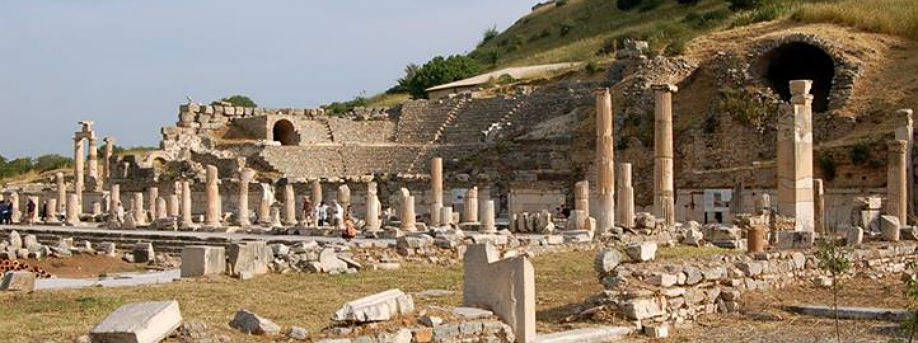

_-2.jpg)
Temple de Serapis
Temple of Serapis
 This temple was built for the Egyptian merchants. It was located on the Commercial Agora near the western gate. There is also another entrance into the temple from the south-west corner of the Agora through stairs.
This temple was built for the Egyptian merchants. It was located on the Commercial Agora near the western gate. There is also another entrance into the temple from the south-west corner of the Agora through stairs.
There are certain indications that suggest the temple was never finished fully. It is estimated that the construction of the temple was started in the 2nd century CE.
There is a statue found inside the temple made by using the Egyptian granite. Also some inscriptions found inside the temple indicate that the temple was constructed for those who believe in Serapis. In Ephesus Museum there is a monument on which the main Goddess of Ephesians, Artemis, and the principal god of Egypt, Serapis, take place together with garland as a symbol of peace.
It is well documented fact that Ephesus had a very strong commercial link with the influential port city of Egypt, Alexandria. During these ancient times Egypt was the biggest producer of wheat. They exchanged wheat with other commercial items from Ephesus and other Ionian cities.
It was converted to a church during the following Christian period. There are remains of a baptisterium in the eastern corner of the temple.
|
Pigna Vatican Museum Courtyard gilt bronze. Rome.
Originally a Roman fountain dating from 1st or 2nd century CE
The bronze pine cone (`Pigna`) at the Cortile della Pigna square. Peacocks from Hadrians Mausoleum (Castel Sant'Angelo) http://pictify.com/130116/pigna-vatican-museum-courtyard Pine cone at the Vatican, flanked by two peacocks.It was at Campus Martius prior to it being moved to the Court of the Pigna.
 glyph-type symbols below the animal (Courtyard of the Pinecone)
glyph-type symbols below the animal (Courtyard of the Pinecone)One version of the pine-cone origins: "Publius Cincius Slavius, whose name appears on the base of the sculpture, built the Pine Cone statue that now resides in the Court of the Pine Cone (Cortile della Pigna) in the Vatican, in the 1st century AD. The piece was originally a fountain that resided in the Temple of Isis in Campo Martius next to the Pantheon. The site of the Temple of Isis is now occupied by the Biblioteca Casanatense but the area is still to this day called Pigna. The fountain is described as having water gushing from the holes in the scales of the cone similar to the Meta Sudans (the sweating rock that was also topped by a pine cone according to some) that still stands outside the Coliseum. The Pine Cone was then moved to the hall of St Peter’s Basilica in the 8th century in the time of Popes John VI, John VII or Zachary (Pope Zachary seems the most likely as he did more than the other two to “Christianize” Rome by building churches over the old Roman temples). One of them moved the Pine Cone from the Temple of Isis to St Peter’s Basilica (the original built by Constantine the Great) where it was covered by a baldachin (it is recreated in this state in the game Assassin’s Creed: Brotherhood where it houses a Piece of Eden). In 1608, when St Peters was being enlarged to its present form the Pine Cone was moved to its current location by Pope Paul V...The bronze peacocks, however, were not part of the original sculpture but are thought to be originally taken from Hadrian’s mausoleum (now Rome’s fortress, the Castel St. Angelo)." http://thedailybeagle.net/2013/09/08/the-pigna-and-the-apollo-belvedere-two-treasures-of-the-vatican/
Another version of the pine cone origins:
[quote]The Huge statue known as the Pigna (pine) or the Fontana Della Pigna depicts a giant Pine Cone. It is located in St. Peter's, in an area called the court of the Pigna.The Court of the Pigna is the northern part of the grand renaissance Belvedere Courtyard that stretches between the Papal Palaces to the "palazzetto" which belonged to Innocent VII's . The courtyard was segmented into three parts after the construction of Sixtus V's Library and the Braccio Nuovo of Pius VII. The present courtyard derived its name form the beautiful pine cone statue set into the "nicchone", borders on the south side with the Braccio Nuovo, and on the east it borders with the Chiaromonti Gallery. To its north you can find Innocent VIII's Palazzetto and on the west the galleries of the Apostolic Library are located.
The pine cone was cast out of bronze in the 1st or 2nd century by the sculptor Publius Cincius Slavius. He was identified as its creator because his name was written on the base of the huge pine. The Statue's height is almost 4 meters and on both sides of the pine cone there are bronze peacocks which are copies of the ones in Hadrian's tomb.
Before it was moved to its current location, known as the Court of the Pigna, the statue of the Pine was situated in the Campus Martius. This area is still known today as "Pigna" after this statue. At its previous location it was used as a fountain with the water pouring from holes pierced in the scales of the cone. At the 8th century it was transferred to the entrance hall of the medieval basilica of St. Peter. It was placed decoratively in the middle of the fountain covered by ornate baldachin. We know this because the statue was identified in Renaissance drawings of the hall. Eventually, during the construction of the current basilica, in 1608, the giant pine cone fountain was moved and situated in its current location.
This statue is a beautiful and ancient one and it's definitely worth stopping by and admiring it as it has been part of Rome's landscape for almost 2000 years! [unquote]
http://vatican.com/photos/gallery/court_of_the_pigna-p45
Masonic cadueceus with pine cone.
![pine cone staff of osiris, pine cone symbolism, occult pine cones, pine pollen benefits, pine pollen powder]() A pair of eagle-headed Annunak flanking a staff capped with a pine-cone.
A pair of eagle-headed Annunak flanking a staff capped with a pine-cone.
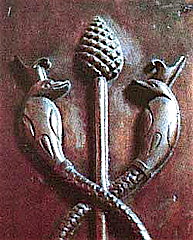 A pair of eagle-headed Annunak flanking a staff capped with a pine-cone.
A pair of eagle-headed Annunak flanking a staff capped with a pine-cone.Assyrian) alabaster Height: 236.2 cm (93 in). Width: 135.9 cm (53.5 in). Depth: 15.2 cm (6 in). This relief decorated the interior wall of the northwest palace of King Ashurnasirpal II at Nimrud. On his right hand, he holds a pine cone. Examples of reliefs of king ashur-nasir-pal II
The Egyptian Staff of Osiris, dating back to approximately 1224 BC, depicts two intertwining serpents rising up to meet at a pinecone. (Photo: Egyptian Museum, Turin, Italy)
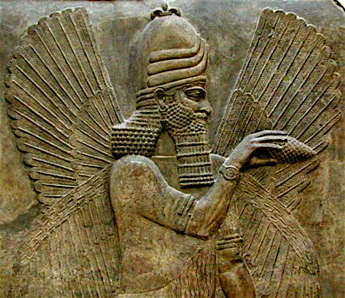 Marduk, winged, holding the pine-cone. Bracelet has safflower hieroglyph. Annunaki, Sumerian.
Marduk, winged, holding the pine-cone. Bracelet has safflower hieroglyph. Annunaki, Sumerian.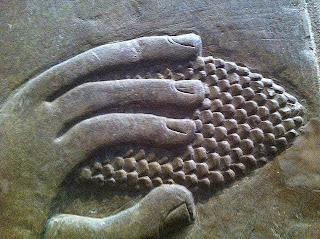
[quote] Detail of pine cone. Standard Inscription.Palace of Ashurnasirpal, priest of Ashur, favorite of Enlil and Ninurta, beloved of Anu and Dagan, the weapon of the great gods, the mighty king, king of the world, king of Assyria; son of Tukulti-Ninurta, the great king, the mighty king, king of Assyria, the son of Adad-nirari, the great king, the mighty king of Assyria; the valiant man, who acts with the support of Ashur, his lord, and has no equal among the princes of the four quarters of the world; the wonderful shepherd who is not afraid of battle; the great flood which none can oppose; the king who makes those who are not subject to him submissive; who has subjugated all mankind; the mighty warrior who treads on the neck of his enemies, tramples down all foes, and shatters the forces of the proud; the king who acts with the support of the great gods, and whose hand has conquered all lands, who has subjugated all the mountains and received their tribute, taking hostages and establishing his power over all countries. [unquote]
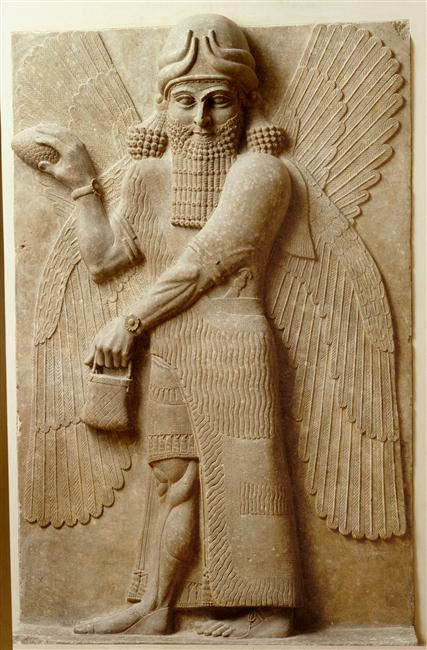 Technical information
Technical informationBlessing genius Neo-Assyrian period, circa 721-705 BCE (reign of Sargon II)
Third gate of the palace of Sargon II, Khorsabad (ancient Dur-Sharrukin), Iraq
Bas-relief of gypseous alabaster
H. 4.09 m; L. 2.36 m; D. 0.75 m
Victor Place excavations, 1852-54
AO 19863
Near Eastern Antiquities [see: Musée du Louvre] ‘Maize’ and ‘pine-cone’ are two hieroglyphs depicted, respectively, on Indian sculptures at Somnathpur (Lakshmi, divinity of wealth) and on sculptures and reliefs of Ashur (Nimrud). Rebus readings are evidence of presence of Meluhha speakers in the Ancient Near East who participated in the bronze-age inventions of tin-bronzes and created the writing systems of deploying hieroglyphs together with cuneiform and Indus texts.
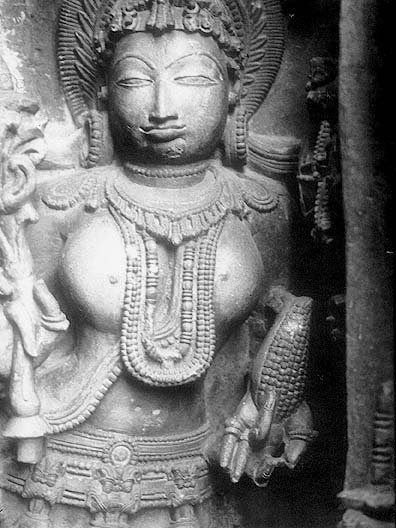 Halebid."Maize breeders in India, China, United States, and Great Britain, who have seen extensive collections of the illustrations, concur...only sculptors with abundant ears of maize as models could have created these illustrations of maize"(Click to enlarge). Photo by Carl L. Johannessen.
Halebid."Maize breeders in India, China, United States, and Great Britain, who have seen extensive collections of the illustrations, concur...only sculptors with abundant ears of maize as models could have created these illustrations of maize"(Click to enlarge). Photo by Carl L. Johannessen.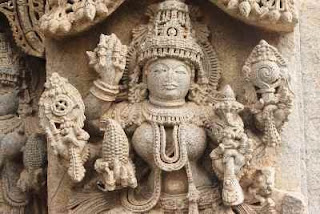

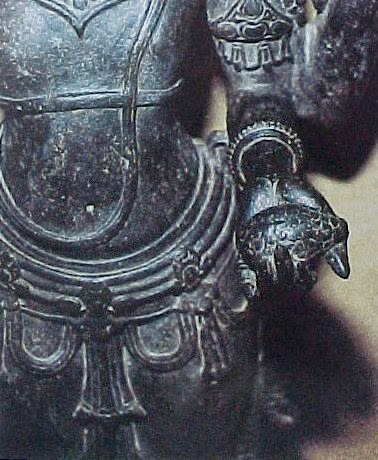
Somnathpur, Halebid. Lakshmi. Divinity of wealth holding maize cob or pine-cone.
Hieroglyphs: kandə ʻpineʼ, ‘ear of maize’. Rebus: kaṇḍa ‘tools, pots and pans of metal’. Rebus: kāḍ ‘stone’. Ga. (Oll.) kanḍ, (S.) kanḍu (pl. kanḍkil) stone (DEDR 1298).
Hieroglyph: కండె [ kaṇḍe ] kaṇḍe. [Telugu] n. A head or ear of millet or maize. జొన్నకంకి.
Rebus:Tu. kandůka, kandaka ditch, trench. Te. kandakamu id. Konḍa kanda trench made as a fireplace during weddings. Pe. kanda fire trench. Kui kanda small trench for fireplace. Malt. kandri a pit. (DEDR 1214).
accord. to Un2. iii , 62 fr. √1. हन् , " to go? ") a goose , gander , swan , flamingo (or other aquatic bird , considered as a bird of passage ; sometimes a mere poetical or mythical bird , said in RV. to be able to separate सोम from water , when these two fluids are mixed , and in later literature , milk from water when these two are mixed ; also forming in RV. the vehicle of the अश्विन्s , and in later literature that of ब्रह्मा ; ifc. also = " best or chief among ") RV. &c; the soul or spirit (typified by the pure white colour of a goose or swan , and migratory like a goose ; sometimes " the Universal Soul or Supreme Spirit " , identified with विराज् , नारायण , विष्णु , शिव , काम
, and the Sun ; du. " the universal and the individual Spirit "; accord. to Sa1y.
resolvable into अहं स , " I am that ") Up. MBh. Hariv. &c; Rebus: हंस 'silver', 'an unambitious monarch'.
There is a possibility that the word hanse may be read rebus as a guild form comparable to the word śreṇi 'guild' in ancient Indian tradition. If so, the hamsa as Vāhana of Sarasvati may be rebus for the Germanic word, hanse 'guild -- artisan/merchant guild'. "The Hanseatic League (/ˌhænsiˈætɪk/; Middle Low German: Hanse, Düdesche Hanse, Hansa; Standard German: Deutsche Hanse; Latin: Hansa Teutonica) was a commercial and defensive confederation of merchant guilds and market towns in Northwestern and Central Europe. Growing from a few North German towns in the late 1100s, the league came to dominate Baltic maritime trade for three centuries along the coast of Northern Europe. It stretched from the Baltic to the North Sea and inland during the Late Middle Ages and declined slowly after 1450."
resolvable into अहं स , " I am that ") Up. MBh. Hariv. &c; Rebus: हंस 'silver', 'an unambitious monarch'.
There is a possibility that the word hanse may be read rebus as a guild form comparable to the word śreṇi 'guild' in ancient Indian tradition. If so, the hamsa as Vāhana of Sarasvati may be rebus for the Germanic word, hanse 'guild -- artisan/merchant guild'. "The Hanseatic League (/ˌhænsiˈætɪk/; Middle Low German: Hanse, Düdesche Hanse, Hansa; Standard German: Deutsche Hanse; Latin: Hansa Teutonica) was a commercial and defensive confederation of merchant guilds and market towns in Northwestern and Central Europe. Growing from a few North German towns in the late 1100s, the league came to dominate Baltic maritime trade for three centuries along the coast of Northern Europe. It stretched from the Baltic to the North Sea and inland during the Late Middle Ages and declined slowly after 1450."





